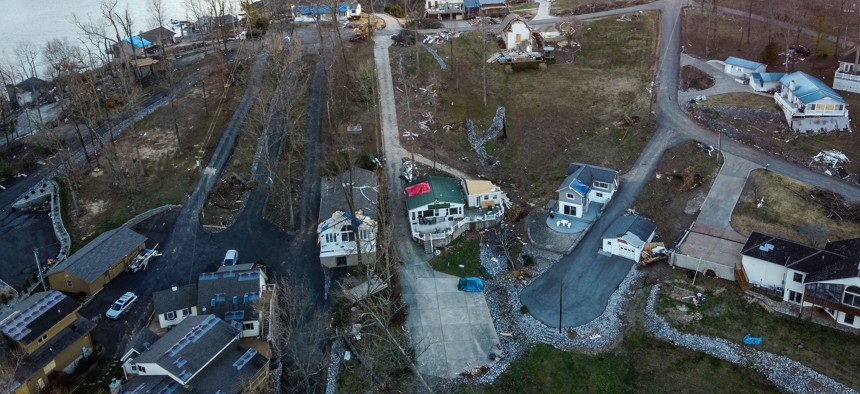Modern Building Codes Slash Energy Costs, Boost Resiliency

Aerial view of a Kentucky neighborhood destroyed by a tornado. CHANDAN KHANNA/AFP via Getty Images
COMMENTARY | Homeowners are demanding features that up-to-date codes can help deliver but almost half of states have not embraced these standards.
Communities rely on buildings to house residents and support businesses. However, many buildings have not been designed, constructed or retrofitted to modern building codes, which are continuously being updated to promote sustainability, efficiency and improved safety standards. But government officials from all levels are racing to prioritize the adoption of energy-efficient tools and strategies.
Addressing Sustainability and Resiliency
With communities searching for solutions to address energy use, reduce emissions and bolster their local economies, adopting and implementing up-to-date energy codes put forth by the International Code Council, an international association of building safety professionals, present officials with a natural, objective solution. These codes are developed on a three-year cycle based on input from professionals throughout the building industry and government officials in order to incorporate new technology, approaches and information.
Modern and innovative model building codes like the International Energy Conservation Code and Chapter 11 of the International Residential Code have been developed to help achieve zero-energy buildings by making improvements in insulation, lighting and mechanical system requirements. Within the last 15 years, usage of IECC residential provisions has reduced energy consumption in buildings by about 40%, highlighting the effectiveness of updated building codes.
The U.S. Department of Energy estimates that from 2010 through 2040, energy codes and standards could save $138 billion in energy costs, equivalent to the emissions of 195 million passenger vehicles, 227 coal power plants or 108 million homes. Additionally, DOE found that the residential provisions of the most recent IECC code provides a 9.4% improvement in energy use and an 8.7% improvement in carbon emissions over past editions—saving homeowners an average of $2,320 over the life of a typical mortgage.
Despite these important successes, almost half of states have not embraced these codes. According to DOE, about 50% of the states have either no energy commercial or residential conservation code adopted statewide (eight total) or are using older code editions that are roughly 20% less efficient than the 2021 standards.
According to a 2020 Dodge Data & Analytics and National Association of Homebuilders survey, more than half (57%) of builders and remodelers rank products/systems related to energy efficiency as the primary request they receive from homeowners, and most (84%) rank it in their top three.
Creating a Stronger Economy
Modern building codes have broader benefits past safeguarding the property and well-being of occupants. They also represent an opportunity for leaders to positively impact the economy on a local and national scale.
For example, with natural hazards like tornadoes, hurricanes, earthquakes and wildfires worsening in frequency and intensity, building codes and standards can help mitigate the structural damage, as well as lessen the overall rebuilding cost. According to a recent Federal Emergency Management Agency analysis, the U.S. would save $600 billion by 2060 if all new buildings were constructed to current editions of the IRC and International Building Code.
Additionally, the National Institute of Building Sciences found that adopting the International Residential and Building Codes generates a national benefit of $11 for every $1 invested.
That same FEMA study also found that 65% of counties, cities and towns across the U.S. have not adopted modern building codes.
Building codes are evaluated and adopted on a state-by-state basis in the U.S., or in some cases by local jurisdictions, leading to a disjointed and inefficient system. Therefore, it is critical to push for the adoption of model codes that foster uniform regulatory requirements and boost economies—only then can our communities achieve their sustainability and resiliency goals, which subsequently will greatly boost market efficiency.
Understanding the importance of providing communities with as many tools as possible, the International Code Council recently released its new framework, Leading the Way to Energy Efficiency, which ICC says provides a path forward on energy and sustainability to confront a changing climate. The framework builds off the success of the IECC and IRC while providing a multi-pronged approach to delivering energy efficiency and other greenhouse gas reduction strategies.
Furthermore, the Code Council launched its “Code on a Mission” challenge, which aims to have over a third of the U.S. population covered by the 2021 IECC by the end of 2023. Industry leaders like the American Council for an Energy-Efficient Economy, Alliance to Save Energy and Energy Efficient Codes Coalition, among others, have shown their support for the initiative.
We are in a race against time to future proof our communities with the tools at our disposal to create sustainable and resilient communities in the long term, and there is no time to waste. While the Code Council has laid the foundation, it is up to us—from local government and business leaders to influential community figures—to promote the adoption, implementation and utilization of a uniform ecosystem of model codes.
By ensuring buildings are designed and constructed to modern building codes and standards, benefits include being able to better mitigate damage from natural hazards, potentially lower operating costs and reducing greenhouse gas emissions, which will contribute to a healthier, more sustainable economy for the future.
Ryan Colker is the International Code Council’s vice president of innovation and serves as executive director of the Alliance for National and Community Resilience.
NEXT STORY: Seaweed Farming Has Vast Potential (But Good Luck Getting a Permit)





